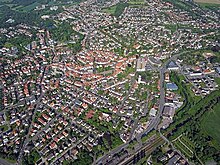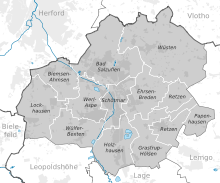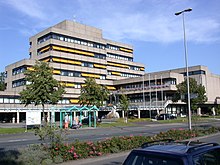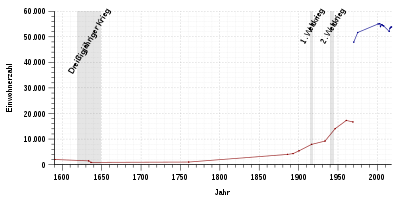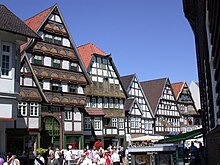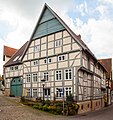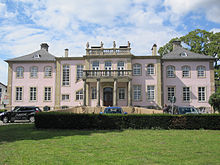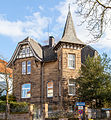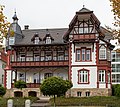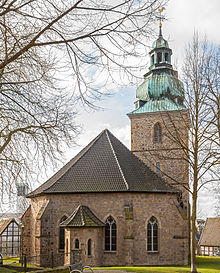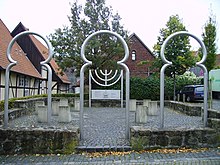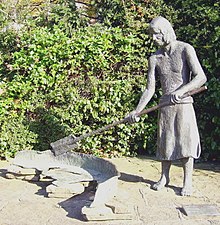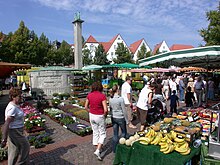Bad Salzuflen
| coat of arms | Germany map | |
|---|---|---|

|
Coordinates: 52 ° 5 ' N , 8 ° 45' E |
|
| Basic data | ||
| State : | North Rhine-Westphalia | |
| Administrative region : | Detmold | |
| Circle : | lip | |
| Height : | 72 m above sea level NHN | |
| Area : | 100.05 km 2 | |
| Residents: | 54,254 (Dec. 31, 2019) | |
| Population density : | 542 inhabitants per km 2 | |
| Postcodes : | 32105, 32107, 32108 | |
| Primaries : | 05222, 0521, 05221, 05232, 05266, 05208, 05228 | |
| License plate : | LIP | |
| Community key : | 05 7 66 008 | |
| LOCODE : | DE BFN | |
| City structure: | 11 districts | |
City administration address : |
Rudolph-Brandes-Allee 19 32105 Bad Salzuflen |
|
| Website : | ||
| Mayor : | Roland Thomas ( SPD ) | |
| Location of the city of Bad Salzuflen in the Lippe district | ||
Bad Salzuflen ( Low German : Iufeln) is a city and a thermal spa in the North Rhine-Westphalian district of Lippe in Germany .
The Staatsbad Salzuflen has been certified as a Kneipp spa since August 2013 , and since 2015 as an “ allergy-friendly community”.
geography
Geographical location
Bad Salzuflen is located on the eastern edge of the Ravensberger Mulde , at the confluence of the Salze and Bega with the Werre . It is densely populated compared to other communities in the north of the Lippe region. The town center is surrounded by rural districts with agricultural land. To the northeast of Werre and Bega, a largely forested range of hills of the Lipper Bergland with elevations of up to 250 meters runs through the urban area. The lowest point is about 34 meters, at the Werre on the border with Herford. The urban area has been part of the Teutoburg Forest / Eggegebirge Nature Park since 2008 .
geology

The urban area is criss-crossed by the river meadows of the Werre, Bega and Salze. Podsol - and Pseudogley - brown soils predominate as soil types. The podsol soils are predominantly found on Tertiary documents , which are criss-crossed by folds from the Mesozoic . Bad Salzuflen is characterized by the salty springs emerging from these folds , to which the region owes the name "Germany's Healing Garden". The area is also well to very well suited for the use of geothermal heat sources by means of geothermal probes and heat recovery with heat pumps (see the adjacent map).
Expansion and use of the urban area
The city of Bad Salzuflen, classified as a " large medium-sized town ", extends over an area of 100.06 km². The urban area has an approximately oval shape with a maximum extension in east-west direction of about 13 km and in north-south direction of 11 km.
| Area according to type of use |
Agricultural schafts- area |
Forest area |
Building, open and operational space |
Traffic area |
Surface of water |
Sports and green space |
other use |
total |
|---|---|---|---|---|---|---|---|---|
| surface | 57.51 km² | 15.01 km² | 17.20 km² | 6.30 km² | 1.22 km² | 2.42 km² | 0.40 km² | 100.06 km² |
| Share of total area | 57.47% | 15.00% | 17.19% | 6.30% | 1.22% | 2.42% | 0.40% | 100.00% |
Neighboring communities
Bad Salzuflen borders the city of Lemgo in the east, Lage in the south and Leopoldshöhe in the southwest . All three communities belong to the Lippe district.
In the west lies the independent city of Bielefeld and in the northwest the city of Herford . In the north, Bad Salzuflen borders on Vlotho in the Herford district . Together with Herford, Bad Salzuflen is part of the Bielefeld agglomeration .
City structure
The city is divided into twelve districts:
- Core city Bad Salzuflen
- Biemsen-Ahmsen
- Ehrsen-Breden
- Grastrup-Hölsen (with Hölserheide )
- Holzhausen (with Sylbach )
- Lockhausen
- Papenhausen
- Retzen (with Volkhausen and Bergkirchen )
- Schötmar
- Werl-Aspe (with kneading heather )
- Wülfer bexes
- Deserts (with Frettholz , Glimke , Hellerhausen , Hollenstein , Pehlen , Pillenbruch , Voßhagen and Waldemeine )
The most populous districts are Bad Salzuflen with around 19,500 inhabitants, Schötmar with 8700, Werl-Aspe with 7400 and deserts with 3800 inhabitants (as of December 31, 2013). Together these four districts make up a good 70% of the Bad Salzufler population. The districts of Bad Salzuflen, Schötmar, Werl-Aspe, Holzhausen and Ehrsen-Breden form a continuous settlement area.
climate
Bad Salzuflen has the moderate, fully humid climate typical of Central Europe with its maximum precipitation in summer. The annual mean temperature of 9.3 ° C corresponds to the latitude and altitude; However, the total annual rainfall of 743 mm is on the one hand slightly higher than the north German (640 mm) or the German average (690 mm), but on the other hand, due to the location in the rain shadow of the Teutoburg Forest, slightly lower than the Lippe average (877 mm).
| Bad Salzuflen | ||||||||||||||||||||||||||||||||||||||||||||||||
|---|---|---|---|---|---|---|---|---|---|---|---|---|---|---|---|---|---|---|---|---|---|---|---|---|---|---|---|---|---|---|---|---|---|---|---|---|---|---|---|---|---|---|---|---|---|---|---|---|
| Climate diagram | ||||||||||||||||||||||||||||||||||||||||||||||||
| ||||||||||||||||||||||||||||||||||||||||||||||||
|
Average monthly temperatures and precipitation for Bad Salzuflen
Source: DWD (1961–1990); wetterkontor.de
|
||||||||||||||||||||||||||||||||||||||||||||||||||||||||||||||||||||||||||||||||||||||||||||||||||||||||||||||||||||||||||||||||||||||||||||||||||||||||||||||||||||||||||||||||||||
Bad Salzuflen is the location of a fully automatic weather station operated by the German Weather Service (DWD) .
history
The discovery of the hand ax from Bad Salzuflen suggests that the area of and around Bad Salzuflen has been inhabited by people at least since the Middle Paleolithic , the Middle Paleolithic. With an age of 350,000 to 300,000 years, the hand ax is considered to be the oldest stone tool found in Westphalia .
In the middle of the 11th century, the "Uflon" settlement and a salt mine located there were first mentioned in writing. “Uflon” means “at the forest” in Old Low German ( uf or up = on or on ; lon or loh = commercial forest, light forest, wood). Later it became "Uflen", also "Mitteluflen" or "Dorf Uflen".
The use of the salty Paulinenquelle led to the construction of the first saltworks in the Middle Ages . These salt workshops were located in a place that is still called “Salzhof” today and whose fountain is depicted in the city's coat of arms.
Thanks to the lucrative salt trade and the promotion under the rule of the Counts of Sternberg , the place expanded. A first chapel was built on the Hallenbrink around 1300 . In 1377 Salzuflen was sold by the Sternbergers to the Counts of Schaumburg . In 1400, Salzuflen finally became the property of the noble lords of Lippe by pledging .
During the Soest feud , the poorly fortified Salzuflen was severely destroyed by Bohemian mercenaries in 1447. In the course of the reconstruction, the place received a circular wall with four gates around 1450 - Schliepsteiner Tor to the north (Exter), Heßkamper Tor to the northeast (Vlotho / Wüsten), Ostertor to the southeast (Schötmar), Herford Gate to the west (Herford) - and three Defense towers, including the Katzenturm , which is still preserved today. In 1488 the town, which was enlarged in this way, was granted town charter by Count Bernhard VII, ruler of Lippe . The trade in white gold flourished until the Thirty Years War and brought great wealth to the city. Magnificent town houses in the Weser Renaissance style and the old town hall, built in 1545/47, bear witness to this heyday.
The Thirty Years' War (1618–1648) ended the city's heyday, which had lasted for almost 200 years. The city was badly damaged by numerous troops marching through. The number of city residents had declined by more than half to 900 by 1645. During the Seven Years' War (1756–1763) the city was again badly damaged. In 1762, a fire caused by lightning destroyed large parts of the city. In 1766 the saltworks was sold to the sovereign Count Simon August zu Lippe . He had the salt works completely modernized and graduation towers built. Since all profits from the saltworks now fell to the sovereign, Salzuflen could no longer benefit from this. As a result, the city developed slowly until the middle of the 19th century. It was not until a bathing establishment founded by Medical Councilor Heinrich Hasse in 1818 that Salzuflen gradually began to revive as a health resort.
Bad Salzuflen became famous for its spa business. With its three drinking, three thermal and three brine springs , it had the status of a Lippe state bath . Although the princely brine bath had been founded almost 100 years earlier, Salzuflen only received the addition of "bath" on April 14, 1914.
The high healing power of the water led to the fact that new bathhouses were built and further springs were drilled, for example the Leopoldsprudel, whose fountain temple is located in the middle of today's spa park. The development to a health resort led to significant changes in the cityscape. The saltworks on the Salzhof ceased salt production and today forms the “town square” where the weekly market and town festivals take place. The graduation towers developed into a place to which people with respiratory diseases withdrew. In the course of time, the long-established industrial sectors disappeared and were replaced by trade and spa services, from which the city's numerous pensions also benefited.
The economic boom in the 19th century was also closely related to the Hoffmann's starch factories founded in 1850 , which later rose to become the largest European starch producer. With the opening of the Herford – Detmold railway line in 1880, Salzuflen was connected to the rail network; the Salzufler station went into operation in 1881.
During the Second World War , Bad Salzuflen largely preserved its strategically insignificant location from bombing raids by the Allies, so that the city survived the war relatively unscathed and became the seat of several military missions after the war .
Religions
There are a large number of religious communities in Bad Salzuflen. Since Bad Salzuflen lies in the now Protestant district of Lippe, the number of Protestant Christians predominates. The seven Evangelical Reformed parishes belong to the Bad Salzuflen class of the Reformed Lippe regional church , the three Evangelical Lutheran parishes with a total of five parishes belong to the only Lutheran class in Lippe. There are also two Roman Catholic parishes in the Archdiocese of Paderborn , seven free church parishes of different religious groups, one New Apostolic parish and two Islamic parishes. There has been no Jewish community in Bad Salzuflen since the time of National Socialism . The closest synagogue is in Herford , it belongs to the Jewish community of Herford-Detmold.
The result of the 2011 census showed the following distribution: Roman Catholic Church: 11.6%, Evangelical Church: 54.5%, other, none, no information: 33.9%.
Administrative history
Two years after the Free State of Lippe was divided into districts, Bad Salzuflen was incorporated into the Lemgo district in 1934 .
After the Second World War, the Free State of Lippe was united with the State of North Rhine-Westphalia by a military ordinance of the British occupying power on January 21, 1947. The city of Bad Salzuflen thus became part of the newly formed Minden-Lippe administrative district on April 1, 1947, which was renamed Detmold administrative district on June 2, 1947 .
As part of the North Rhine-Westphalian regional reform , the two cities of Bad Salzuflen and Schötmar as well as the ten communities of Biemsen-Ahmsen, Ehrsen-Breden, Grastrup-Hölsen, Holzhausen, Lockhausen, Papenhausen, Retzen, Werl-Aspe, Wülfer-Bexten and Wüsten became the first January 1969 merged to form the new town of Bad Salzuflen as part of the implementation of the “Law on the Reorganization of the Lemgo District” . In addition, small parts of the communities Krentrup, Nienhagen and Welstorf were incorporated.
As part of the implementation of the Bielefeld Act , the Lemgo and Detmold districts were merged on January 1, 1973 to form the new Lippe district, to which Bad Salzuflen has belonged since then.
Population development
Population development until the end of 1968, only Salzuflen:
|
|
When the "new" town of Bad Salzuflen was founded on January 1, 1969 (Bad Salzuflen and Schötmar with the ten districts) there were 47,930 inhabitants, which corresponded to a population density of 479 inhabitants per square kilometer
Development of the population from January 1, 1969:
All information for the city of Bad Salzuflen within the limits since 1969; As of December 31 of the previous year:
|
|
|
Residents in the districts of the city of Bad Salzuflen on January 1st, 1969:
| District | Residents | Area (km²) | Inhabitants / km² |
|---|---|---|---|
| Bad Salzuflen | 16,690 | 13.76 | 1,213 |
| Schötmar | 9.132 | 4.89 | 1,867 |
| Biemsen-Ahmsen | 1,493 | 5.90 | 253 |
| Ehrsen-Breden | 2,498 | 7.00 | 357 |
| Grastrup-Hölsen | 1,019 | 7.90 | 129 |
| Holzhausen | 2,865 | 8.36 | 343 |
| Lockhausen | 2,706 | 9.32 | 290 |
| Papenhausen | 115 | 3.12 | 37 |
| Retzen | 1,436 | 7.14 | 201 |
| Werl-Aspe | 5,083 | 6.31 | 806 |
| Wülfer bexes | 1,683 | 7.74 | 217 |
| Deserts | 3,181 | 18.62 | 171 |
| total | 47.901 | 100.06 | 479 |
politics
Bad Salzuflen belongs to the Lippe I state electoral district , in which Ellen Stock (SPD) was elected as a direct candidate in the 2017 state elections . At the federal level, Bad Salzuflen belongs to the Lippe I constituency , in which Kerstin Vieregge (CDU) was elected as a direct candidate in the 2017 federal election .
City council
The city council currently has 48 seats. The voting chairman of the city council is Mayor Roland Thomas (SPD). The following table shows the local election results since 1975:
Allocation of seats in the city council:
| 2014 | 2009 | 2004 | 1999 | 1994 | 1989 | 1984 | 1979 | 1975 | ||||||||||
|---|---|---|---|---|---|---|---|---|---|---|---|---|---|---|---|---|---|---|
| Political party | Seats | % | Seats | % | Seats | % | Seats | % | Seats | % | Seats | % | Seats | % | Seats | % | Seats | % |
| CDU | 17th | 36.32 | 17th | 35.47 | 18th | 37.69 | 25th | 52.87 | 23 | 46.83 | 20th | 37.34 | 21st | 39.77 | 24 | 46.23 | 24 | 46.31 |
| SPD | 16 | 34.10 | 16 | 34.15 | 18th | 36.58 | 16 | 32.48 | 20th | 40.42 | 24 | 46.38 | 23 | 43.83 | 23 | 45.86 | 23 | 44.40 |
| FDP | 3 | 6.12 | 5 | 10.13 | 4th | 6.99 | 3 | 5.07 | 0 | 4.84 | 4th | 8.88 | 3 | 6.87 | 4th | 7.92 | 4th | 9.29 |
| GREEN | 4th | 8.67 | 4th | 8.38 | 4th | 7.35 | 2 | 4.75 | 4th | 7.91 | 3 | 7.40 | 4th | 9.44 | - | - | - | - |
| FWG 1 | 3 | 5.75 | 2 | 3.81 | 2 | 5.18 | 2 | 4.83 | - | - | - | - | - | - | - | - | - | - |
| LEFT | 2 | 3.82 | 2 | 3.40 | 0 | 2.38 | - | - | - | - | - | - | - | - | - | - | - | - |
| WFU 2 | - | - | 1 | 2.62 | 2 | 3.83 | - | - | - | - | - | - | - | - | - | - | - | - |
| BIS 3 | 1 | 1.59 | 1 | 2.06 | - | - | - | - | - | - | - | - | - | - | - | - | - | - |
| BLBS 4 | 1 | 1.52 | - | - | - | - | - | - | - | - | - | - | - | - | - | - | - | - |
| Pirates | 1 | 2.12 | - | - | - | - | - | - | - | - | - | - | - | - | - | - | - | - |
| DKP | - | - | - | - | - | - | - | - | - | - | 0 | 0.10 | - | - | - | - | - | - |
| Total 5 | 48 | 100 | 48 | 100 | 48 | 100 | 48 | 100 | 47 | 100 | 51 | 100 | 51 | 100 | 51 | 100 | 51 | 100 |
| voter turnout | 49.49 | 52.47 | 57.62 | 55.62 | 82.72 | 67.76 | 70.24 | 75.38 | 88.24 | |||||||||
1 Free community of voters
2 We for ourselves
3 Citizens' Initiative Future
4 Colorful List Bad Salzuflen
5 without taking into account rounding differences
The council member of the BLBS joined the pirate party after the local election and forms a parliamentary group with the elected council member of the pirates. One of the council members of the left also joined the pirate faction in 2019, so that it now consists of 3 council members.
mayor
Roland Thomas (SPD) has been the city's full-time mayor since 2015. His predecessors were Wolfgang Honsdorf (SPD, 2004–2015), Gerhard Kleemann (CDU, 1999–2004), Heinz-Wilhelm Quentmeier (SPD, 1983–1999), Kurt Dröge (CDU, 1975–1982) and Heinrich Welslau (SPD, 1969-1975). Until 1999 the mayor's office was honorary.
Coat of arms, flag and banner
| Banner, coat of arms and flag | |

|

|

|
|
The Bad Salzufler city coat of arms shows in blue a hexagonal red well shaft with two silver (white) gallows trees, on which a rising, behind a sinking golden (yellow) bucket hangs, above a golden (yellow) eight-pointed star. It was last approved on March 31, 1970 by the district president in Detmold. The coat of arms, documented since the 16th century, goes back to a seal from 1375. The fountain indicates the salt springs and the star indicates that it was part of the Sternberg county .
The city's flag and banner are blue-white-blue in a ratio of 1: 2: 1; the flag striped crosswise with the city coat of arms shifted forward in the median; the banner striped lengthways with the city arms in the median above the center.
Town twinning
Bad Salzuflen has had a partnership with Millau in the Aveyron department in southern France since 1975 , with the former Borough of East Yorkshire in England , whose center was the seaside resort of Bridlington , since 1979 , and with Luckenwalde in the Brandenburg district of Teltow-Fläming since 1990 . There are two working groups that occasionally organize trips to the two twin cities in France and England.
Attractions
Half-timbered houses
The inner city still has a large number of mostly gable-free and richly carved half-timbered houses from the 16th and 17th centuries. So Long Road 3 (1590) and Lange Straße 5 (1650) can be found in the pedestrian zone in addition to the half-timbered houses salter road 2 (1551), to 9 one of the most important surviving Weserrenaissance - ensembles in East Westphalia. These include the houses: Lange Straße 33 (1612), a half-timbered gable house with richly carved work and utlucht , Lange Straße 37 (1623), a half-timbered gable house with utlucht, and Lange Strasse 41, Haus Obermeier, built in 1618 with its richly carved facade in the 19th century was changed. In the former hall there is a fragmentary Renaissance fireplace. From 1982 to 2010 the city and bath museum was housed in the house. The houses in the pedestrian zone are all well preserved, but mostly changed on the ground floor by converting them into shops with shop windows.
Other noteworthy half-timbered houses are in the area around the market, such as B. Am Markt 17 (1658), Steege 2 (1572) and Lange Straße 1 (1659), which was partly built above the Salze . The most beautiful houses, some of which have been extensively restored in recent years, can be found in the old town of Bad Salzuflen. Examples are: Obere Mühlenstrasse 1, the former Backs house is probably the most magnificent half-timbered house in the city, Wenkenstrasse 8 (1631), a three-storey gabled house with an acute-angled floor plan, Wenkenstrasse 10a (1520), a three-storey gable house with a massive basement as well as compartments filled with brick in the ornamental association is the oldest building dated by an inscription, Schennershagen 9 (1550), whose builder Anna Wange was burned as a witch in 1556, as well as the ensemble, consisting of the houses Ritterstraße 2, 6, 8 and Schennershagen 2, 3, 4, the from 1990 renovated, connected and expanded to the Hotel Arminius (from 1889 in Ritterstraße 2). A number of other restored half-timbered houses in the old town are on Wenkenstrasse, Dammstrasse, Obere Mühlenstrasse, Ritterstrasse, Brunnengasse, Schennershagen and opposite the city wall on Turmstrasse.
House Schuseil
Turmstrasse 23
Renaissance stone buildings

In addition to the many half-timbered houses, there is a small group of remarkable stone buildings from the Renaissance around the historic town hall . The town hall, built between 1545 and 1547, was built both for the needs of the administration and for representation. Drinking room, wedding, dance and guild hall, court room, party room and filing chamber, fire brigade equipment room and ammunition room for the shooters, storage rooms for linen and tithe grain: everything united under one roof. There is no information available about the builders of the house, built in the Renaissance style with a narrow gable front and raised gable. The three coat of arms stones on the facade (city arms, rose and star) were added there later. Likewise, the neo-Gothic staircase at the front, which was added there from 1859–60 according to plans by Karl Overbeck. Opposite the historic town hall is the Gießenbier house (Am Markt 32). The mayor Jobst Gießenbier had the two-storey quarry stone building built in 1533. Next to it is the Barkhausen house (Am Markt 34) with an originally simple, late Gothic gable, which was redesigned into a splendid Renaissance gable around 1590. Other buildings in this series are Am Markt 36, the facade of the stone house, which was built around 1600, was redesigned around 1860/70 and provided with a balcony, and Am Markt 38, built in 1620. The Brandes founded by Rudolph Brandes has been in this building since 1792 ' cal pharmacy . The oldest dated house in town is in the immediate vicinity. According to dendrochronological studies, 1510/19 was built on Markt 23 . The building served as a rectory from 1765 to 1869. In the 18th century, the stone gable was replaced by a half-timbered construction due to its dilapidation. The rear building with the hall was also preserved.
In total there are around 60 listed half-timbered houses and magnificent stone buildings from the Renaissance in the city center of Bad Salzuflen, with more in the districts.
city wall
Today only a few parts of the city wall between the house at Osterstrasse 46 and Otto-Künne-Promenade, as well as in Mauerstrasse and Turmstrasse with the Katzenturm are preserved. The name of the tower can be traced back to the Middle High German word "Katte", which means something like jump . At times the Katzenturm was also called the “thief tower” because crooks and thieves had to serve their sentences in a holding cell here. This defense tower was an important part of the medieval early warning system located at the highest point of the city fortifications with a direct line of sight to the Blunt Tower , which was built as a watchtower at the latest in the course of the city fortifications after 1447. It is still in ruins today on Alte Vlothoer Straße, about two and a half kilometers from the city of Bad Salzuflen, and is still about 5.5 meters high.
Castles and estates
The Stietencron Castle in Schötmar was in the style of late 1729-1732 baroque built. The client was the owner of the Schötmar manor, the Swedish and Hessian Minister of State August Moritz Abel Plato von Donop. After changing owners, the complex became the seat of the von Stietencron family in 1831 . From 1909 it was expanded to include the new entrance hall and the stairwell on the entrance side. In 1949 the castle and park became the property of the town of Schötmar. The Bad Salzuflen Music School has been based in Stietencron Castle since 1983. Weddings are held in the rococo hall of the castle.
The Good Steinbeck is already mentioned in documents in 1320 in the village manor deserts. Count Simon VI. turned the farm into a manorial dairy at the beginning of the 17th century. Johann Heinrich von Lengerke (1825–1906) from Bremen acquired the manor in 1864 and had a manor house built in the Tudor Gothic style in 1869 . The building, which is not open to the public, is a listed building.
The Schwaghof farm castle is located on the site of the former Schwaghof estate about three kilometers north of the city center. The two-storey building made of quarry stone essentially dates from the late Middle Ages. The half-timbered floor and the roof date from the beginning of the 17th century. The building was used as a granary, among other things. Above it, with its about 1 meter thick walls, it offered refuge for the courtiers as a keep.
19th century Wilhelminian style architecture
The recent economic upswing in Bad Salzuflen at the end of the 19th century can still be seen today in the cityscape of some well-preserved examples of Wilhelminian architecture, predominantly in the neo-Renaissance style . Around the former city and later district court Am Markt 25, built in 1879/80 in the style of the neo-renaissance, the representative residential and commercial buildings at Lange Straße 21, Am Markt 16 (Uekermann house built 1898/99) and Am Markt 30 (residential and Hanke commercial building, built in 1898). Further examples are the Salzufler Bahnhof (opened in 1881), the former Rector's School in Turmstrasse 2 / 2a (built in 1879/80), which is also known as the “Red School” because of the red bricks used, and the former secondary school, built in 1898/99 in Hermannstrasse 32 (today VHS ). Wilhelminian style architecture can also be found in the districts, such as the post office building built for Schötmar in 1895. This was built on behalf of the Imperial Post Office Directorate Minden at Schloßstraße 10 and later expanded several times.
Villas and resort architecture
With its thermal and brine springs, the city developed into a Lippe state bath from 1818 and in 1914 was given the name “bath”. This of course had an impact on the development of the city and resulted in a whole series of new buildings in the style of the time. Between 1855 and 1906, a number of classicistic bathing and treatment houses were built in the area of the rose garden, such as Bathhouse I (1855–56), the Leopold Bath (1903) and the Inhalatorium (1903) which are still used today, albeit partly in a different function , are well preserved. In the Parkstrasse area, the Kurhaus (1900) with the Kurtheater (1908) and a large number of guest houses and villas in Bismarckstrasse and Parkstrasse were built according to plans by Fritz Seiff. The most important of these buildings is undoubtedly the Villa Dürkopp , built in the neo-baroque style in an exposed location between 1914 and 1917 as the retirement home of the Bielefeld factory owner Nikolaus Dürkopp . Also worth mentioning are Parkstrasse 4 (Erdbrügger House), Parkstrasse 13 (Villa Kurpark), Parkstrasse 15 (Villa Luise), Parkstrasse 39 (Seeblick House) and the “Fürstenhof” hotel (built in 1908, Park sanatorium since 1959). Further guest houses and Art Nouveau villas can be found in Wald-, Wenken- or Moltkestrasse. A group of four picturesque Art Nouveau villas in Waldstrasse 1 and 3 and directly opposite 18 and 20 are particularly worth seeing. Many buildings from 1909 were designed by the well-known Salzufler architect Rudolf Günther (1880–1941), such as Haus Hansa, Parkstrasse 36–38, the house Wenkenstrasse 1–5, Am Herford Tor 9 and the house Bender, a corner building in an exposed location (corner of Bleichstrasse / Parkstrasse), one of the most important, to this day preserved buildings of the spa architecture of the early 20th century in Westphalia.
Modern and contemporary architecture
The notable buildings of classical modernism in the New Building style include the dance hall “Rheingold”, built in 1933, Lange Straße 18, as well as the parish hall of the evangelical-reformed community Bad Salzuflen in Von-Stauffenberg-Straße, built in 1928 according to a design by Rudolf Günther 3. A typical example of the spa architecture of the early 1960s is the concert hall built in 1961 with an adjoining foyer. World-famous architects such as Günter Behnisch (1922–2010), who u. a. designed the Munich Olympic Park or the new plenary hall of the German Bundestag in Bonn , have left their mark on Bad Salzuflen. The spa guest center, built by Behnisch & Partner in 1981–83 , received an award in 1985 from the Association of German Architects , North Rhine-Westphalia. With its roof construction made of stalked plates, adapted by Frank Lloyd Wright ( Johnson Wax Headquarters 1939), it shapes the entire area in front of the spa park entrance. Since November 2011, the spa guest center has been the city's youngest architectural monument. Just as the architect Rudolf Günther in particular shaped the cityscape at the beginning of the 20th century, at the turn of the millennium it was the Salzufler architects Schmidt / Schmersahl + Partner with buildings such as the Sparkasse head office in Bahnhofstraße, the award-winning car park at Ostertor, the competition that won the redesign of the Salzhof and the sub-assembly on Untere Mühlenstrasse, which, with its small parts and the adapting of medieval formats and roof shapes, blends in particularly harmoniously with the historic cityscape and was developed by the Westphalian Office for Landscape and Building Culture together with other new buildings, e.g. B. the development on Langen Strasse opposite the Salzhof, is cited as a positive example of urban renewal.
Industrial culture

As early as the Middle Ages, Bad Salzuflen had a few windmills and water mills with pre-industrial production in addition to salt production, both in the urban area and in the settlements that were later incorporated. For example, the old town mill can still be found in the city center at Dammstrasse 7.
From the middle of the 19th century, various industrial companies settled in Salzuflen, some of whose buildings still exist today. Hoffmann's starch factories , the oldest industrial company in Bad Salzuflen, was founded on September 29, 1850 by Heinrich Salomon Hoffmann on today's Hoffmannstrasse. The company, which had risen to become the largest European starch producer, employed around 1200 people around 1900, making it not only the most powerful commercial enterprise in the city, but also in what was then the state of Lippe . Production at the Salzufler site was discontinued in 1990 and only a few buildings such as the administration building and the fire station are preserved today. Carl Friedrich Wolff (1799–1879) founded the Wolff cigar factory in 1853, which was initially located at the market in Schötmar and from 1888 at the intersection of Eduard-Wolff-Strasse and Schlossstrasse. The August Dedert chocolate and biscuit factory was founded in 1898. From the factory that was closed in 1965, the Dedert factory owner's villa with production building from 1933 at Uferstrasse 20 u. 20a received. In the 20th century, the Lippische Celluloidwarenfabrik (today Licefa) was established in 1927, as well as a branch of the Werther'schen Zuckerwarenfabrik, today August Storck KG , in 1938 . With the outbreak of the Second World War, operations were discontinued a short time later.
Another example of industrial culture in the city center is the building of the Gerlach printing works from 1926, designed by Rudolf Günther, at Salzsiederstraße 2. The newspaper Lippischer Allgemeine Anzeiger was printed here until 1941 .
Spa facilities
Thermal springs
Bad Salzuflen's oldest well-preserved spring is the Paulinenquelle on the Salzhof, drilled at a depth of 63 meters in 1802 and named after Princess Pauline zur Lippe (1769–1820). The Salzuflen spa did not exist at this time, but the drilling to secure the brine for salt production was very important and is now used as a graduation spring. The Paulinenquelle was built over in 1934 with the fountain monument jointly designed by the architect Rudolf Günther and the sculptor Gustav Reitner. In the middle of the spa park is Bad Salzuflen's landmark, the fountain temple above the Leopold thermal spring. With the development of this thermal bath in 1906, Salzuflen became a thermal bath. Godfather was the last ruling Prince of Lippe, Leopold IV. Zur Lippe (1871–1949). Together with the Loosebrunnen, the two Sophienquellen, Sophienbrunnen, Neubrunnen, Inselbrunnen as well as the Gustav-Horstmann-Sprudel and Therme III, there are nine thermal springs, mostly located in the course of the Salts , in the city area.
Graduation towers

A remnant of the salt production are the graduation towers, often incorrectly referred to as saline , with a length of 424 m in the past and around 300 m today. Of the four original graduation towers, only two have been completely preserved. A third, whose origins go back to the 17th century, had to be demolished because it was in disrepair. After a council decision it was rebuilt as an adventure graduation and was inaugurated on July 28, 2007. Today the graduation towers are only operated for spa purposes. The brine trickling down over blackthorn bundles the air near the graduation house and enriches it with salt, and the water droplets bind particles in the air. Inhaling salty air humidifies the airways and has a positive effect on the walls of the respiratory organs. In addition, the fine salt crystals have a secretion-dissolving effect, which intensively cleanses the respiratory tract of bacteria and causes the mucous membranes to swell.
Spa facilities
The city of Bad Salzuflen has designated two spa areas: the Obernberg spa area to the west of the spa park and the Asenberg spa area to the east of the spa park. In addition to the spa guest center, there is also the spa house with spa and city theater, a theater with 498 seats without its own ensemble, on Parkstrasse. It is regularly performed by the Detmold State Theater and changing ensembles. A walking and drinking hall opposite and the adjacent concert hall with an outdoor stage complete the spa facilities around the spa gardens.
Parks and landscaped gardens
The so-called rose garden, which was originally laid out in 1872 by the royal court gardener Johann Georg Kahl, is located between the graduation tower on Parkstraße and the Leopold-Bad. After it was changed a lot in the meantime, it was repaired again in 2009 according to old plans. At the spa guest center is the entrance to the spa park with the adjoining landscape park . 120 hectares are available for long walks and are one of the largest park landscapes in Germany. The spa park from 1907, which is subject to entry, stretches along the Salts with meadows, old trees and a generous number of flowers. At the large Kurparksee with its fountain and boat rental, the park turns into the non-entry landscape garden and flows into a game reserve as well as in the city forest with its cycling and hiking trails up to the Salzufler Bismarck tower on the Vierenberg , the Herford Bismarck tower , the Loose or something hidden lying small lake at the Blunt Tower . The Bad Salzuflen spa gardens have been part of the European Garden Heritage Network (European Garden Network, EGHN for short) since 2008 .
In Bad Salzuflen there are also the small parks on the upper Waldstrasse and on the Walhallastrasse on the Asenberg and the castle park in Schötmar with old trees.
Therapy centers
- The vital center with the institute for tinnitus research and therapy
- The Vitasol Therme houses several brine baths under one roof with thermal water up to 38 ° C from 1,018 m depth, a sauna park that is widely integrated into the landscape, a fitness club, beauty and wellness center, a vitality restaurant, sports and exercise therapy, and a children's club.
Clinics and rehabilitation centers
- Klinik Lipperland, Am Ostpark 1, rehabilitation clinic for mental and psychosomatic illnesses of the German Federal Pension Insurance
- Rehabilitation clinic am Lietholz, Lietholzstrasse 31, orthopedic and rheumatological specialist clinic of the German Federal Pension Insurance
- Salzetalklinik, Alte Vlothoer Straße 1, Center for Oncological and Orthopedic Rehabilitation of the German Pension Insurance Westphalia
- Median Klinik am Burggraben, Alte Vlothoer Straße 47–49, specialist clinic for medical rehabilitation
- Median Clinic NRZ Bad Salzuflen, Forsthausweg 1, Clinic for Neurology
- Salinenklinik, Salinenstrasse 2, preventive and rehabilitation clinic
- Lippische Nervenklinik Dr. Spernau, Waldstrasse 2, Specialized Hospital for Psychiatry and Psychotherapy
- Klinikum Lippe , Heldmanstrasse 45, specialist clinic for child and adolescent psychiatry
Culture
Sacred buildings
The first Christian church in the region was built around the year 800 AD at the location of today's evangelical-reformed Kilian 's Church (neo-Gothic) on the church square in Schötmar . It is the original parish for many localities in the surrounding area. It is a three - aisled neo - Gothic hall church with a 5/8 end . The west tower has an octagonal upper floor, which is crowned by a ridge-like lantern with a steep tent roof.
The Evangelical Reformed town church is located on the so-called Hallenbrink, the highest elevation within the Bad Salzufler old town. The hall building, which is essentially late medieval, was rebuilt in 1762 after a fire. In 1892 the building was extensively renovated and expanded. The tower in front of the nave is late Gothic. His Welsche hood dates from 1782. The most important piece of equipment is the pulpit made by Heinrich Kampmeyer in 1765 . The parish hall near the town church is a plastered building with a stepped gable , which was built in 1928 in expressionistic forms.
The Evangelical Lutheran Church of the Redeemer in Martin-Luther-Straße is a neo-Romanesque church building from historicism 1891-1892 based on a design by the architect Hermann Held (Bethel) under the supervision of Karl Siebold (Schildesche). The foundation stone was laid on July 12, 1891, and the inauguration took place on May 8, 1892, Sunday Jubilate . 1908–1909 the church was extended by Karl Siebold to include the western part with the tower, another extension took place in 1939 by Gerhard Balke (Bethel).
The Catholic Church of Our Lady is on the corner of Grabenstrasse and Woldemarstrasse. With the groundbreaking on September 23, 1956, construction of the church began based on a design by the Paderborn architect Josef Lucas ; the foundation stone was laid on December 8, 1956. The consecration took place on March 8, 1959 under the title: "Mary, our dear wife, Queen of Peace".
The Evangelical Lutheran Church of the Resurrection on the corner of Gröchteweg and Volkhausenstrasse was built between 1964 and 1966 according to plans by the architect Heinrich Loos (Bad Salzuflen). The artist couple Hans-Helmuth and Margarete von Rath (Bad Salzuflen) played a key role in the artistic design. The foundation stone was laid on July 13, 1964; the church was consecrated on May 1, 1966, Sunday Jubilate. The Church of the Resurrection is shared by the Lutheran and Reformed parishes.
There is a church of the New Apostolic Church in Schötmar at Gerberweg 27.
The Mevlana Camii mosque of the Turkish-Islamic community, which belongs to the umbrella organization Turkish-Islamic Union of the Institute for Religion (DİTİB), was opened in 2012 and is located on Weinbergstrasse in Schötmar. It is named after the religious scholar Maulana Jalal ad-Din Muhammad Rumi (1207-1273), who is called "Mevlânâ" (our Lord / Master) by his followers. The building is not only a place of prayer, but also a cultural and meeting center with a tea room, rooms for Islamic classes, for German and tutoring courses and integration work.
There is also the Vahdet mosque of the Islamic community Millî Görüş "At the Crooked Pasture" in Schötmar.
Memorials and memorials
Memorials in memory of Jewish culture
During the pogrom night of November 9th to 10th, 1938, the Salzufler synagogue on Mauerstrasse, which had been the place of worship of the Jewish community for 83 years, was desecrated and the panes of the windows were destroyed. The attempt at arson was prevented by the chief police officer on duty. The police secured writings and sacred objects from being destroyed. The damage caused by the destruction was repaired on November 12, 1938 by the local technical emergency aid group Bad Salzuflen and the property was tidied up and secured. In 1941 the remains of the synagogue were blown up by the technical emergency aid and the property was cleared. On November 9, 1982, a memorial plaque was attached to a wall next to the synagogue site at the suggestion of the DKP local group Bad Salzuflen. The text read "Here stood the synagogue / the Israelite / Bad Salzuflen community / which was destroyed on November 9, 1938 / by the National Socialists / / Exodus 3.5" . In 1998, the present memorial was erected on the plan of the synagogue according to plans by the architect Paul Dahlmeier.
The now closed Jewish cemetery Salzuflen on Werler Strasse was first mentioned in a document in 1607. It was almost completely destroyed during the National Socialist era . The remaining tombstones were re-erected on a part of the area after the war. In 1988 the city acquired the remaining area from private ownership, redesigned the cemetery and erected a memorial. 64 Holocaust victims from Salzuflen and Schötmar are named on the memorial in the form of a seven-armed candlestick ( menorah ) .
In 2008, a small memorial plaque was erected at the former Schötmar Jewish cemetery on Oerlinghauser Strasse. The cemetery, located south of today's Werre cemetery and occupied from 1871 to 1955, was not destroyed during the Nazi era. There are still 63 well-preserved tombstones ( Mazewot ) on it.
Stumbling blocks
Since November 2010, the artist Gunter Demnig has laid more than 60 stumbling blocks in Salzuflen and Schötmar in memory of the victims of the Nazi dictatorship .
War memorials
There are memorials to the victims of the wars in various cemeteries. There is a memorial stone on the sports field in Ehrsen-Breden; There are cenotaphs in the cemetery in Biemsen-Ahmsen, in Wüsten, Retzen, Wülfer-Bexten and in the palace gardens in Schötmar. The war memorial in Bad Salzuflen stands above the Obernbergfriedhof in the forest. It was designed by Hermann Hosaeus and built in 1923. Every year, commemorative events are held at all of these locations on Memorial Day .
Monuments to history
A number of monuments remind of the historical development of the city. For example, the “salt boiler” monument at the Salzhof represents a salt boiler around 800 BC. It was designed and executed by the Herford sculptor Marianne Bleeke-Ehret and installed in May 1988.
The sculpture "Salzufler Lebensbaum" made of bronze and granite stands in front of the new town hall on Rudolph-Brandes-Allee. It was created by Axel Seyler ( Ostwestfalen-Lippe University of Applied Sciences , Detmold Campus) and set up on September 8, 1984. The roots of the tree of life symbolize: the rural through the portrait of the arable citizen and Salzufler original master blacksmith Peter, the health resort through the head of the medical councilor Heinrich Hasse , the founder of the spa , and the urban through the head of the pharmacist Rudolph Brandes .
The monument “to the gallows dispute” stands between Salzuflen and Schötmar on the former city limits on the Salzufler side at the intersection of Rudolph-Brandes-Allee / Walhallastraße. On the left side there are two councilors and the Salzufler coat of arms, on the right the Kilian Church and laughing children, in the middle the sinners under the gallows. The council from Schötmar had asked the Salzufler council to be allowed to use their gallows. This request and the reaction is written on the relief in the Lippian Platt :
“Mol de Schötmersken want to hang on the Jufler gallows' n Sünner. De Galgen - reup de Jufler Rot De es för us un iuse Kinner
Leuwe Jufler - The gallows wui jui gladly but the laughter over Jübben wuisen Rot Dat is För us un iuse Kinner "
Monuments to personalities
The obelisk in honor of the pharmacist Simon Rudolph Brandes (1795–1842) has stood on a small lawn since 1979 at the confluence of Riestestrasse and Rudolph-Brandes-Allee. The monument to Eduard Hoffmann , son of the founder of Hoffmann's starch factories , was dedicated by the workforce in 1900 on the occasion of the 50th anniversary of the factory. It is located on Hoffmannstrasse, between the cemetery and the former fire station. The main entrance to the factory used to be across the street.
As in many German cities, there is also a Kaiser Wilhelm monument in Bad Salzuflen , which was erected in 1897 by the village of Schötmar on the occasion of the centenary of the birth of Kaiser Wilhelm I in a park on Walhallastraße, as well as a Bismarck tower , a square, 18th century Meter high tower on the Vierenberg near the hamlet of Hollenstein. The tower was inaugurated in 1900 and renovated in 1999 and 2004.
Sports
Nationally successful clubs are handball Bad Salzuflen and in table tennis the clubs TuS Bexterhagen and SC Bad Salzuflen, both of which compete at the national league level. It is worth mentioning the HC 93 Bad Salzuflen , which played in the 2nd handball Bundesliga in the past , but then broke up. In football was TuS Bad Salzuflen successful in the early 1950s and played three years in the highest amateur league Westphalia. In 1978 the TuS merged with the Turnerbund Deutsche Eiche Schötmar to form SC Bad Salzuflen , which has played in the district league since 2014.
music
In addition to the church choirs , church, youth, gospel and brass choirs in the parishes exist a large number of other choirs (male choirs, female choirs, mixed choirs). School choirs have formed in the schools, which (usually once a year) go public with a larger concert. There is a parent-teacher choir (ELCH) in the Aspe school center. The gospel choir Get Up is supra-congregational . There is also the Bad Salzuflen City Music School in Stietencron Castle and the Bad Salzuflen Orchestra, a spa band that plays several times a week to entertain the spa guests in the concert hall.
Bad Salzuflen gained youth cultural significance in the mid-1980s through the label Fast Weltweit , from which bands such as Blumfeld and Die Sterne emerged in connection with the Hamburg School . Other musicians and bands like Bernd Begemann , Bernadette La Hengst , Silversurfer and Summery Mind also come from Bad Salzuflen and were active there.
Nature reserves and natural monuments
In the urban area of Bad Salzuflen, seven nature reserves are designated with the Salzetal , Glimketal , Stadtwald , Masch , Bachtal bei Grünau , Bexter Wald and Holzhauser Bruch , which together have a protected area of around 424 hectares .
Regular events
- The Bad Salzuflen Marathon has been held annually on the last Saturday in February since 1993. It is organized by LC 92 Bad Salzuflen.
- Ecumenical service on Ascension Day at the Salzhof to commemorate the saltworks day, which was first used by the city council in 1515.
- Classical festival of the Northwest German Philharmonic in the concert hall at Whitsun.
- Garden and ambience - annual midsummer garden event in the spa gardens.
- Shooting festivals in Schötmar (end of July) and Bad Salzuflen (mid-July).
- Wine festival: At the Salzhof (2nd weekend in August).
- Beer brewer festival: At the Salzhof (in spring).
- Night of 10,000 candles - an annual event in the spa park in late summer, where the flower beds and seascapes shine romantically with many candles and lanterns.
- Kiliansfest: Annual folk festival in Schötmar in honor of St. Kilian in October.
- Christmas dream : Annual Christmas market on the Salzhof and in the entire city center (from the end of November until after Christmas).
- New Year's Eve Open Air - annual New Year's Eve party with fireworks at the turn of the year at the Kurpark.
- Weekly markets in Schötmar on the market square on Wednesdays and Saturdays, as well as on the Salzhof; weekly on Tuesday and Saturday mornings.
Culinary specialties
There are no culinary specialties especially for Bad Salzuflen, with the exception of the Lippe dishes Pickert and Himmel und Erde . Seasonal popular is kale eat. This includes a juniper schnapps at the end .
Other cultural attractions
In addition to being a health resort and the possible activities mentioned above, the city also offers other attractive leisure activities. Extracts from the offer:
- Hortus Vitalis adventure park - maze of thuja hedges.
- Golf course of the golf and country club Bad Salzuflen v. 1956 e. V. at the Schwaghof.
- Canoe tours on the Bega and Werre rivers with a locally represented, regional operator.
- Mini golf at the Loose country restaurant
- The Heerser Mühle environmental center, a facility for environmental education and training, outdoor area, adventure trail, workshop, around 37 hectares of working and viewing biotopes. The site is freely accessible.
Economy and Infrastructure
traffic
Street
Bad Salzuflen is on federal highway 239 . The A 2 touches the urban area and ensures quick accessibility from east and west via the access and exits (28) Ostwestfalen / Lippe and (29) Herford / Bad Salzuflen. Today's Lockhauser Strasse connects the east and west of the city. The two previously existing roads via Bega and Werre were unable to accommodate traffic in the city area. Therefore, the construction of this four-lane elevated road in the city became necessary in the early 1980s. To the south of the city center, Ostwestfalenstrasse runs from the A 2 to Lemgo and Bielefeld.
Rail and bus transport
The Bad Salzuflen station, which went into operation in 1881, is on the Herford – Altenbeken railway line . It is served every hour by the RB 72 "Ostwestfalenbahn" Herford - Lage - Detmold - Altenbeken - Paderborn . There are further stops in the districts of Schötmar and Holzhausen ( Sylbach stop ). Between 1909 and 1924, the Bad Salzufler and Schötmarschen Straßenbahn GmbH trains ran in Bad Salzuflen . Between 1903 and 1963 Bad Salzuflen was on the Wallenbrück - Vlotho line of the Herford small railway .
A new city bus system has opened up the urban area since September 1994 . The buses of the four city lines meet every 60 minutes at the “Am Markt” meeting point. The operator of the lines is Stadtverkehrsgesellschaft Bad Salzuflen mbH, a subsidiary of Stadtwerke Bad Salzuflen. The surrounding cities of Bielefeld , Herford , Lemgo and on weekdays Oerlinghausen can be reached by regional buses from the central bus station. Bad Salzuflen is part of the TeutoOWL tariff area of the Westphalian tariff .
In the long distance bus Bad Salzuflen, between May 2015 and October 2016 was a stopping point of the post bus . In the course of the takeover of the Postbus company by Flixbus , this long-distance bus connection was temporarily discontinued. Bad Salzuflen has been connected to the Europe-wide Flixbus network since April 2017.
The tourist " Paulinchen-Bahn " runs on a circuit in the spa area . The starting point is the main entrance to the spa park, at the graduation tower.
bicycle
The Radfernwege wellness cycling route and BahnRadRoute Weser-lip cross Bad Salzuflen. There are also local bike paths, u. a. the Soleradweg . A cycle path has been marked in the landscape spa park along the Salze, all other paths in the spa park are closed to cyclists. A heavily used bike and footpath leads directly along the Werre to Herford.
Hiking trails
In addition to many hiking trails signposted by the city, some long-distance hiking trails also run through the city:
The 45 km long “Salt Trail” leads around Bad Salzuflen. It roughly follows the city limits and leads through the districts of Holzhausen, Wülfer-Bexten, Lockhausen, Biemsen-Ahmsen, Bad Salzuflen itself, Wüsten, Retzen, Papenhausen and Grastrup-Hölsen.
The 77-kilometer Karl-Bachler-Weg begins at Salzufler train station , named in honor of the meritorious Lippe hiking father Karl Bachler , who died in Bad Salzuflen in 1976 at the age of 90. It leads via Vlotho, Hohenhausen, Rinteln , Bad Eilsen and Bückeburg to Rehburg-Loccum in the district of Nienburg / Weser .
The 72-kilometer Hansaweg , which comes from Herford and leads to the pied piper town of Hameln on the Weser , runs through the urban area .
Established businesses
- Alba Moda , women's fashion mail order company
- Coko factory , plastic injection molding
- Dorma Glas , manufacturer of fittings for glass doors
- Essmann , systems for everything to do with flat roofs and facades
- Maritim hotel company , hotel chain
- Messe Ostwestfalen , including the Custombike , ZOW and various consumer fairs
- Sollich , manufacturer of special machines for the confectionery industry
- Stadtwerke Bad Salzuflen , the regional energy supply company
media
The only local newspaper in the Lippe district is the Lippische Landes-Zeitung after the Lippische Rundschau was discontinued at the end of 2003 . Bad Salzuflen im… as a journal with an event calendar is published all year round by Verlag Dröge Schötmar GmbH in cooperation with the city of Bad Salzuflen and the Staatsbad Salzuflen. The Lippische Latest News , Lippischer Anzeiger , The City-Anzeiger Bad Salzuflen-Schötmar-Ortsteile , Lippe aktuell are free city gazettes; der Salzstreuner is a Bad Salzufler city magazine.
Bad Salzuflen belongs to the reporting area of the WDR studio Bielefeld and Radio Lippe , both of which cover local reporting.
education
The city offers all types of schools and has eight local primary schools , three school kindergartens and the two equivalent school centers Lohfeld and Aspe. In the Lohfeld school center there is a secondary school , a secondary school and a grammar school . There is a secondary school and a comprehensive school in the Aspe school center . In addition, there is a school for people with learning disabilities , the Erich Kästner School , but no new classes will be formed from the 2016/17 school year. All Bad Salzuf primary schools, the Lohfeld secondary school, the Eduard Hoffmann secondary school, the Aspe comprehensive school and the Erich Kästner school are all-day schools . In 2014, the city's schools with 385 teachers taught a total of 5,077 students, 1,782 of them in elementary schools, 348 in secondary schools, 1,002 in secondary schools, 1,048 in grammar schools, 722 in comprehensive schools and 175 in special schools.
23 day-care centers offer a total of around 1,600 places for preschool support for children. In addition, there are 50 places in day care centers for school children. The municipal music school and adult education center complement the educational offer.
Personalities
Honorary citizen
- Eduard Hoffmann (1832–1894), manufacturer. Awarded on June 5, 1888. It brought the Hoffmann's starch factories, founded by his father and important for the development of the city, to world fame.
- Otto von Bismarck . Awarded for his 80th birthday in 1895, jointly with the other towns in the state of Lippe .
- Reinhold Meyer (born February 13, 1833 in Bückeburg , † April 2, 1910 in Salzuflen), secret medical council . Awarded in February 1909. Erich Reinhold Leberecht Meyer practiced in Salzuflen since 1872. He was the head of the municipal hospital and the children's hospital. As a doctor, he has made great contributions to the city.
- Paul von Hindenburg . Awarded on April 28, 1933 "as the patron of the new Germany".
As in many other German cities, Adolf Hitler (April 28, 1933), Otto Dietrich (February 14, 1934), Heinrich Hoffmann (January 15, 1936) and Joseph Goebbels (September 1936) were granted honorary citizenship in Bad Salzuflen . In the course of removing traces of National Socialism, the Salzuflen municipal council, under the supervision of the British, deprived them of their honorary citizenship rights on June 12, 1945. No further honorary citizenship rights have been granted since then.
Other personalities
In addition to the honorary citizens, other well-known personalities were born in Bad Salzuflen, grew up or played a significant role in the development of the city. To be mentioned here are above all Heinrich Hasse , medical councilor and city physician in Bad Salzuflen and initiator of the bathing business, Rudolph Brandes , co-founder of the pharmacists 'association (today's German Pharmacists' Association ), Heinrich Salomon Hoffmann , founder of " Hoffmann's starch factory ", Jürgen von der Lippe , Thomas Helmer , Michael Diekmann , Rudolf Günther , Arnold Schönhage , Kurt Müller , Hans-Ulrich Wittchen and Ute Frevert .
literature
- Gerhard Bachler: Salzuflen in the old days . Verlag FL Wagener, Lemgo 1977, ISBN 3-921428-20-3 .
- Franz Meyer (Hrsg.): Bad Salzuflen epochs of city history . Publishing house for regional history, Bielefeld 2007, ISBN 978-3-89534-606-4 .
- Franz Meyer (Ed.): 500 years of the city of Salzuflen 1488–1988 - Documentation of the speeches, exhibitions and lectures on the city anniversary . Publishing house for regional history, Bielefeld 1989, ISBN 3-927085-15-4 (on behalf of the city of Bad Salzuflen).
- Karl Müller: The geological walls in the Badestadtmuseum Salzuflen . Tölle & Co., Detmold.
- Karl Heinz Paetzold: From Salzuflen's past days . MPS Verlag, Bad Salzuflen 2008, ISBN 978-3-00-025945-6 .
- Bad Salzuflen. Data and structures of a medium-sized city . Regional history publishing house, 1996.
- City and Bath Museum Bad Salzuflen . Schnell & Steiner, 1988.
- The Church of the Resurrection of the Ev.-luth. Parish in the state bath Salzuflen . Schnell & Steiner, Munich / Zurich 1988.
- Herbert Stöwer: Westphalian City Atlas, Volume II, 2 parts . On behalf of the Historical Commission for Westphalia and with the support of the Regional Association of Westphalia-Lippe / Bad Salzuflen City Map, Dortmund / Altenbeken 1981, ISBN 3-89115-345-7 .
- Karl Slawinski: Re-urbanization of the historic city center - development strategies illustrated using the example of the city of Bad Salzuflen . Dorothea Rohn, Detmold 2012, ISBN 978-3-939486-67-1 .
Web links
- Website of the city of Bad Salzuflen
- Website of the Staatsbad Salzuflen GmbH
- Aerial views of the city center
- Image archive from Bad Salzuflen at Lipperland.de
- historical house inscriptions in Bad Salzuflen
- Bad Salzuflen in the Westphalia Culture Atlas
- Website of the Bad Salzuflen train station event center
- Website of the city magazine Salzstreuner
Individual evidence
- ↑ Population of the municipalities of North Rhine-Westphalia on December 31, 2019 - update of the population based on the census of May 9, 2011. State Office for Information and Technology North Rhine-Westphalia (IT.NRW), accessed on June 17, 2020 . ( Help on this )
- ↑ platdeutsch-niederdeutsch.net
- ↑ Geological Service NRW: Using geothermal energy - geothermal study provides planning basis . ( Memento from September 14, 2005 in the Internet Archive ) (PDF; 360 kB)
- ↑ a b ( page no longer available , search in web archives: State Office for Data Processing and Statistics North Rhine-Westphalia: municipal profile Bad Salzuflen )
- ^ Website of the city of Bad Salzuflen: Population.
- ↑ DWD Climate Data Germany
- ↑ wetterkontor.de
- ^ DWD: station directory
- ↑ a b c d e Franz Meyer (Ed.): Bad Salzuflen Epochs of City History . Publishing house for regional history, Bielefeld 2007, ISBN 978-3-89534-606-4 .
- ↑ GenWiki Bad Salzuflen.
- ^ Hoffmann's starch factories AG. Westfälisches Wirtschaftsarchiv Foundation, archived from the original on July 24, 2001 ; Retrieved June 5, 2014 .
- ^ Population and households - Bad Salzuflen community, city. (PDF) Archived from the original on April 28, 2014 ; accessed on October 21, 2014 .
- ↑ Announcement of the Military Ordinance No. 77 of January 21, 1947 (PDF; 476 kB), reproduced on the lwl.org portal of the Westphalia-Lippe Regional Association, accessed on October 13, 2014.
- ↑ Martin Bünermann: The communities of the first reorganization program in North Rhine-Westphalia . Deutscher Gemeindeverlag, Cologne 1970.
- ↑ Martin Bünermann, Heinz Köstering: The communities and districts after the municipal territorial reform in North Rhine-Westphalia . Deutscher Gemeindeverlag, Cologne 1975, ISBN 3-555-30092-X .
- ^ Franz Meyer: 500 years of the city of Bad Salzuflen 1488–1988 , p. 129.
- ^ Office for data processing and statistics NRW.
- ^ Lippische Landeszeitung: All SPD candidates prevail in Lippe.
-
↑ State database NRW; Election results for the municipality code 05766008.
State Office Information and Technology NRW: Local elections.
Election of the council 1999.
Municipal data center Minden-Ravensberg / Lippe: City council election 2004 - Bad Salzuflen.
Local election results 2014 - ↑ bad-salzuflen.ratsinfomanagement.net
- ↑ https://piratenfraktionbadsalzuflen.wordpress.com/piratenfraktion-erhaelt-unterstuetzung/
- ↑ Franz Meyer (Ed.): Bad Salzuflen - Epochs of City History. Publishing house for regional history, Bielefeld 2007, ISBN 978-3-89534-606-4 , p. 95.
- ↑ hotelarminius.de History of Arminius, accessed on May 22, 2015.
- ↑ Georg Dehio , under the scientific direction of Ursula Quednau: Handbuch der deutschen Kunstdenkmäler. North Rhine-Westphalia II Westphalia . Deutscher Kunstverlag , Berlin / Munich 2011, ISBN 978-3-422-03114-2 , p. 76.
- ↑ Franz Meyer (Ed.): Bad Salzuflen - Epochs of City History. Publishing house for regional history, Bielefeld 2007, ISBN 978-3-89534-606-4 , p. 82.
- ↑ Franz Meyer (Ed.): Bad Salzuflen - Epochs of City History. Publishing house for regional history, Bielefeld 2007, ISBN 978-3-89534-606-4 , p. 37.
- ↑ Georg Dehio, under the scientific direction of Ursula Quednau: Handbuch der deutschen Kunstdenkmäler. North Rhine-Westphalia II Westphalia . Deutscher Kunstverlag , Berlin / Munich 2011, ISBN 978-3-422-03114-2 , p. 77.
- ^ Anne Herden-Hubertus: The spa guest center in Bad Salzuflen. In: Preservation of monuments in Westphalia-Lippe, issue 1.12. Ardey-Verlag, Münster 2012, pp. 33–38 ( PDF ).
- ↑ Salzhof architectural competition. City of Bad Salzuflen, accessed on May 26, 2015 .
- ↑ Properly preserved and designed in the historic city center. (PDF) Westphalian Office for Landscape and Building Culture, accessed on May 26, 2015 .
-
↑ Stefan Wiesekopsieker: From the Lippische Celluloidwarenfabrik to Licefa. (PDF) Retrieved May 27, 2015 . August Storck KG: 1938 New plant in Schötmar. Retrieved May 27, 2015 .
- ↑ Glossary. Bad Salzuflen State Baths, archived from the original on June 1, 2015 ; accessed on May 31, 2015 .
- ^ Lippische-Landeszeitung: Median-Gruppe invests in Bad Salzuflen , accessed on January 17, 2017
- ↑ City magazine Bega-Blatt on the opening of the Mevlana Mosque ( Memento from March 4, 2016 in the Internet Archive )
- ^ Lippische-Landeszeitung: Two associations run mosques in the Lippe district.
- ↑ City Archives Bad Salzuflen; City of Salzuflen, file C 21.
- ↑ Franz Meyer (Ed.): Bad Salzuflen - Epochs of City History. Publishing house for regional history, Bielefeld 2007, ISBN 978-3-89534-606-4 , p. 97.
- ↑ The Jewish cemetery in Schötmar (PDF)
- ↑ List of nature reserves in the Lippe district
- ↑ Lippischer Heimatbund u. Landesverband Lippe (Ed.): Heimatland Lippe. Detmold, May / June 2012 edition, ISSN 0017-9787 , p. 148.
- ^ Regional Association Westphalia-Lippe: Environmental Center Heerser Mühle in LWL GeodataKultur
- ^ City of Bad Salzuflen, building files registry, building files "Bahnhofstrasse 41".
- ↑ Lippische Landeszeitung: Postbus runs for the last time on Monday.
- ↑ Lippische Landeszeitung: Flixbus will run from Bad Salzuflen again from April.
- ↑ Lippische Landeszeitung: The Flixbus drives back to the Salzufler ZOB.
- ^ City of Bad Salzuflen: Secondary schools
- ↑ Wolfgang Bender (Berab.): The hand on the pulse of time. Lippe's everyday history at the end of the 19th century as reflected in official medical reports. Detmold 2000, p. 34.



